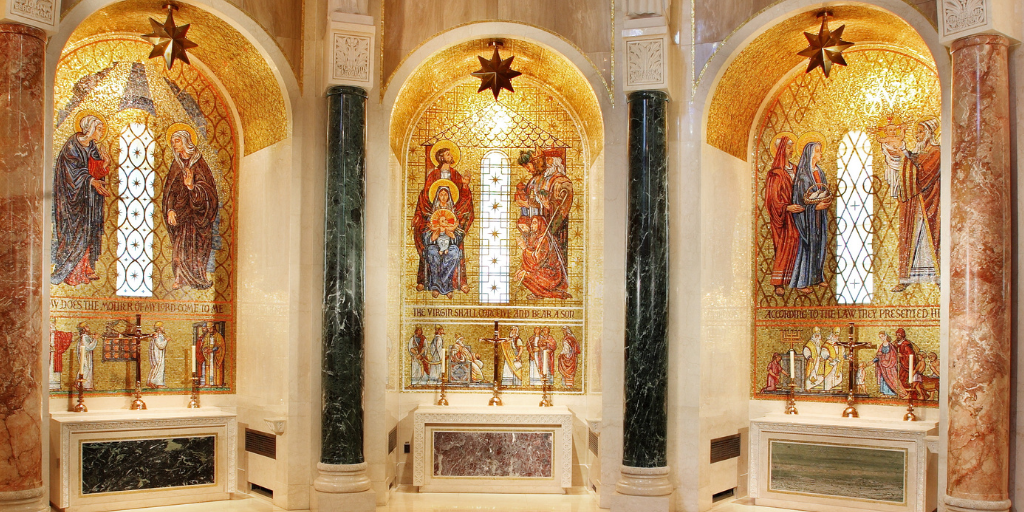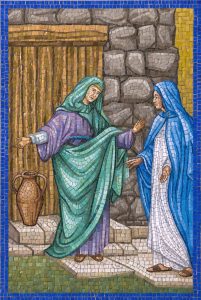
“The people who walked in darkness
have seen a great light;
Upon those who lived in a land of gloom
a light has shone.” Isaiah 9:1
In today’s post, we invite you to contemplate five pieces of art in the Basilica as we prepare our hearts for the celebration of Christ’s birth. From elegant marble reliefs to vivid chapel mosaics, they each reflect significant aspects of the Christmas story. Read more about these inspiring works of art and what they mean for the faithful.
1. The Annunciation Relief

Portrayed in the south façade, the Annunciation marks the moment Mary learned she was to bear the Messiah: the angel Gabriel came to Mary and told her that she would bear the Son of God, who would bring redemption to the world.
“Then the angel said to her, ‘Do not be afraid, Mary, for you have found favor with God. Behold, you will conceive in your womb and bear a son, and you shall name him Jesus. He will be great and will be called Son of the Most High, and the Lord God will give him the throne of David his father, and he will rule over the house of Jacob forever, and of his kingdom there will be no end.’” – Luke 1:30-33
The Annunciation reminds us that God is sovereign over all things and His infinite power is beyond our comprehension. When Mary asked the angel Gabriel “how can this be?” he reminded her, “Nothing will be impossible for God.” The miraculous nature of Christ’s entrance into the world also serves as proof of His divinity; Jesus was conceived in the Virgin Mary not of man, but of the Holy Spirit.
2. The Visitation Mosaic
Depicted in the Rosary Walk and Garden, the Visitation is the joyous meeting of Mary and her cousin Elizabeth during their pregnancies. Both found themselves pregnant in unusual circumstances – Elizabeth in her old age after suffering from infertility, and Mary by the Holy Spirit. At their meeting, John the Baptist leapt in the womb of Elizabeth, and she blessed Mary and the Christ Child. Mary, in turn, responded with the famous Magnificat praising the Lord.
Elizabeth’s story reflects the theme of expectation and fulfillment that is central to the Christmas story: just as she waited through years of barrenness before conceiving, so too did the Israelites wait for centuries before seeing the promised Messiah.
3. The Nativity Chapel Mosaic
Shortly before Mary was due to give birth, she and Joseph traveled to Bethlehem for the census since he was of the line of David. When they arrived, they could find no place to stay, and Mary had to give birth in a stable. An angel appeared to shepherds in the fields outside the city, proclaiming the Christ Child’s birth.
“The angel said to them, ‘Do not be afraid; for behold, I proclaim to you good news of great joy that will be for all the people. For today in the city of David a savior has been born for you who is Messiah and Lord. And this will be a sign for you: you will find an infant wrapped in swaddling clothes and lying in a manger.’ And suddenly there was a multitude of the heavenly host with the angel, praising God and saying: ‘Glory to God in the highest, and on earth peace to those on whom his favor rests.’” – Luke 1:10-14
The shepherds came and visited the Child, telling Mary and Joseph what had happened, and praised God.
In the Nativity Chapel, the birth of Christ is depicted with its Old Testament parallel of Isaiah prophesying the Messiah’s virgin birth in Isaiah 7:14:
“Therefore the Lord himself will give you a sign. Behold, a young woman shall conceive and bear a son, and shall call his name Imman′u-el.”
This piece of art not only guides us to reflect on the beauty of Christ’s birth, but of how Christ fulfilled centuries-old prophecies in His coming – of how Christ is the long-awaited Messiah.
 4. Column Portrayal of The Magi
4. Column Portrayal of The Magi
Portrayed in a column capital in the Crypt Church, the Magi saw the star from afar and traveled to worship the Christ Child, bringing Him gifts of gold, frankincense and myrrh. Each of their gifts tells us something about Jesus’ identity; the gold represents Jesus’ kingship, which transcends all earthly rulers; the Magi recognized that and came to worship Him. The frankincense represents Jesus’ deity, as in the Old Testament, frankincense was traditionally burned in the temple as an offering to God (Leviticus 2:2). By bringing this gift, the Magi affirmed Jesus was no ordinary man; He was both fully man and fully God. Finally, the gift of myrrh, which was commonly used to embalm bodies at the time, foreshadows Jesus’ death.
As the Magi actively pursued Jesus, so too should we follow Christ without hesitation, letting Him be our guiding light.
5. The Incarnation Dome
Measuring 3,780 square feet, the Incarnation Dome features four different events surrounding the Incarnation of Jesus: the Annunciation, the Nativity, the Wedding Feast at Cana, and the Transfiguration. Around the base of the dome is the text of John 1:14:
“The Word became flesh and made his dwelling among us, and we saw his glory, the glory of the Father’s only Son, full of grace and truth.”
The beauty and mystery of the Incarnation is that Christ was at once fully man and fully divine. In coming to earth as a human being, Christ both experienced the limitations and temptations of being a man, while fully embodying divinity.
Above all, the Incarnation Dome guides our attention to the central truth of Christmas: that in Christ, God became man so that He could be our Savior. As the Nicene Creed says:
“For us men and for our salvation
he came down from heaven,
and by the Holy Spirit was incarnate of the Virgin Mary,
and became man.”
Source:
Rohling, Geraldine M., PhD, MAEd. The Basilica of the National Shrine of the Immaculate Conception: Guide and Tour Book. Washington, D.C.: Basilica of the National Shrine of the Immaculate Conception, 2018.




